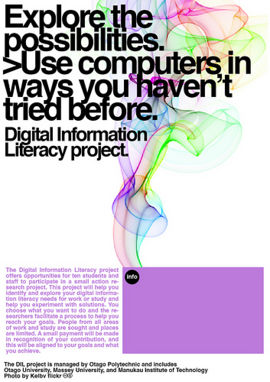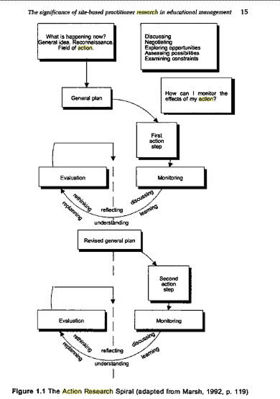Digital Information Literacy Project
Contents
Introduction
This research project was supported by a grant from the Ministry of Education Tertiary eLearning Research fund (TeLRF). This is a collaborative research project led by Otago Polytechnic researchers in partnership with researchers at the University of Otago, Massey University and Manukau Institute of Technology.
The goals of the project are were to investigate and develop the digital information literacy capability of tertiary students and staff, and evaluate the impact of this on lifelong learning, productivity and innovation in the NZ context. Within this were specific project objectives, which for the application needed to align with specific outcomes provided by the Ministry of Education.
Research outputs
This research project is now completed, and the following outputs are available.
- Hegarty, B., Penman, M., Kelly, O., Jeffrey, L., Coburn, D. & McDonald, J. (2010). Digital Information Literacy: Supported Development of Capability in Tertiary Environments. New Zealand: Ministry of Education. http://www.educationcounts.govt.nz/publications/tertiary_education/80624
- Kelly, O., Coburn, D., Hegarty, B., Jeffrey, L., & Penman, M. (2009). Don’t dilly dally on the way: Driving towards digital information literacy capability. In Same places, different spaces. Proceedings ascilite Auckland 2009. http://www.ascilite.org.au/conferences/auckland09/procs/kelly-o.pdf
Media releases
Interviews were conducted by Radio New Zealand and Radio ZM with Bronwyn Hegarty. A media release was prepared by the Otago Polytechnic Communications Officer, Katie Ellwood.
- Key Skills - Reading, Writing and Digital Literacy? http://www.otagopolytechnic.ac.nz/about/news/reading-writing-and-digital-literacy.html
Projects
Handy resources to get started
- Digital information literacy information about this topic and materials for setting up blogs, using the Internet, using RSS, creating digital resources etc.
- Online information literacy modules for any situation e.g. essay writing, searching, evaluating, writing reports and much more.
- YouTube - EPIC 2015 - A prediction of the Future, the Evolving Personalized Information Construct by GoogleZone.
Contacts
- Bronwyn Hegarty - project manager and research coordinator: bronwynDOThegartyATgmailDOTcom
- Merrolee Penman - lead researcher: merroleeATgmailDOTcom
Research objectives
- Investigate how staff and students access, and interpret digital information creating their own understandings, using purpose built modules which are customisable and/or Web 2.0 strategies.
- Ascertain how personal online learning environments and membership in a social networked community can influence digital information literacy.
- Indicate how important digital information literacy is for lifelong learning of staff and students (including Māori and Pasifika).
- Determine the standard of digital information literacy in the New Zealand working-age population compared with other OECD countries.
Background
The research project is very timely given the emphasis by the current government on increasing the knowledge and skills of New Zealanders. Digital information literacy is one aspect of information literacy which is very relevant for the 21st Century (WikiEducator, 2007) where the focus is on the creation of a Knowledge Society. According to Hon David Cunliffe (Ministry of Economic Development, 2005), there is still some way to go in New Zealand to create a Knowledge Society which not only has instantaneous and available connections to diverse, high quality, content, but where there are users with “the capability and confidence to use it [technology] to fully enrich their lives” (p. 1). In essence, there is a need as never before, for capable learners and teachers who are digitally information literate.
Definitions of digital information literacy
Descriptions associated with digital information literacy have been established by various bodies. Information literacy is defined by the American Library Association (2006) as the ability to locate, evaluate and effectively use information. Digital information fluency is further defined as knowing how digital information is different from print information; having the skills to use specialized tools for finding digital information; and developing the dispositions needed in the digital information environment (Illinois Mathematics and Science Academy, 2007). In addition the Australian and New Zealand Institute for Information Literacy (ANZILL) suggests that the principles of independent learning, personal fulfilment, using information for decision making, and lifelong learning “underpin information acquisition, understanding and application” (Bundy, 2004, p 11).
These are all areas essential for tertiary students to develop for the many aspects of study which can encompass anything from online enrolment through to accessing and using course materials, drawing on resources to preparing assignments, checking final exam marks, and communicating with their peers and lecturers. Not only is knowledge and skills required in the area of digital information literacy for successful learning, but graduates with digital information capability are essential players in the workforce in a knowledge society.
Development of DIL Definition for Australasia
One of the objectives for the DIL project is to develop a definition of digital information literacy for Australasia. As part of this process, please add your suggestions on the Development of DIL definition (DoDD) page.
Cultural considerations
This research project has a clear mandate to consider the importance of digital information literacy for including Māori and Pasifika staff and students. Therefore it will be essential to consult with the Kaitohutohu of Otago Polytechnic regarding the process of recruiting, collection of data, analysis and interpretation of the data. In this way the unique perspectives of Māori staff and students can be equally represented alongside that of Pākehā staff and students. The same process will also be used with the research team approaching Pasifika Liaison staff to determine the most appropriate mechanisms of recruiting, collecting, analysing and interpreting the data from Pasifika staff and students.
Previous research
The project builds on earlier funded research undertaken for the Tertiary eLearning Research Fund (Hegarty, Penman, Brown, Coburn, Gower, Kelly, & Moore, (2005) as well as studies undertaken by staff of Otago Polytechnic (Blackall, 2005; Penman, 2006).
Action Research
The method that we are using to frame this research project in order to answer the questions is action research. For those who do not know much or anything about action research, it is a qualitative research method used predominantly within education. Action research is cyclical with the following steps (McNiff, 2007) being used to systematically capture what has happened in the research process.
The process is illustrated by the action research spiral diagram from Coleman and Lumby (1999). Click on it to enlarge.1. Start with a problem or issue; 2. Explore possible solutions (General Plan); 3. Select one solution (First action step) and act on it; 4. Discuss, think and learn (Monitoring); 5 Evaluate the solution - did it solve the issue or problem or not (Evaluate)?
If not, go back and choose another solution and trial it (Monitoring), and evaluate - did it work or not? Finally you change your practice based on what you discovered or learned (Revised general plan).
References
- Coleman, M., Lumby, J. (1999). The significance of site-based practitioner researcher in educational management. In: D. Middlewood, M. Coleman, & J. Lumby (Eds.). Practitioner research in education: making a difference (pp. 1-20). London: Paul Chapman Publishing.
- McNiff, J. (2002). Action research for professional development. Concise advice for new action researchers.
- McNiff, J. (2008). The significance of ‘I’ in educational research and the
responsibility of intellectuals. South African Journal of Education, 28, 351-364. Retrieved February 3, 2009, from http://sajournalofeducation.co.za

